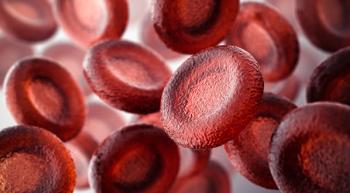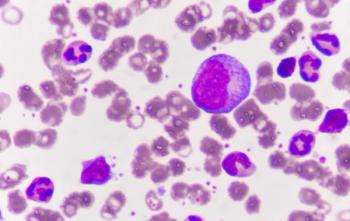
Belantamab Mafodotin Granted FDA OK in R/R Multiple Myeloma
BCMA-targeting ADC belantamab mafodotin was approved for use in patients with relapsed/refractory multiple myeloma after 2 or more lines of treatment.
Belantamab mafodotin-blmf (Blenrep) has been approved by the FDA for use in combination with bortezomib (Velcade) and dexamethasone (BVd) for the treatment of patients with relapsed or refractory multiple myeloma who have been treated with 2 or more prior lines of therapy which include a proteasome inhibitor and an immunomodulatory agent.1,2
How effective is BVd in relapsed/refractory multiple myeloma?
The approval is based on results of the open-label, randomized, multicenter phase 3 DREAMM-7 trial (NCT04246047), which evaluated BVd vs standard-of-care daratumumab plus bortezomib and dexamethasone (DVd). Results of DREAMM-7 demonstrated that patients receiving BVd had a median progression-free survival (PFS) of 31.3 months (95% CI, 23.5-not reached [NR]) vs 10.4 months (95% CI, 7-13.4) in the DVd arm, decreasing risk of disease progression or death by 69% (HR, 0.31; 95% CI, 0.21-0.47).
Additionally, the median overall survival (OS) was NR in the BVd arm compared with 35.7 months in the DVd arm (95% CI, 21.1-NR). This data revealed a 51% reduction in the risk of death for this patient population (HR, 0.49; 95% CI, 0.32-0.76).
How safe is belantamab mafodotin?
Regarding the safety of belantamab mafodotin, ocular toxicities are a key concern. Prescribing information for the agent includes a boxed warning for the risk of ocular toxicity, which can include corneal epithelium changes that lead to vision deterioration.
Most patients receiving BVd in DREAMM-7 experienced ocular toxicities (92%), with 83% of patients on the regimen requiring dose modification. For 77%, ocular toxicities were grade 3 or 4.
“For ocular toxicity, the main [adverse] effects that patients will experience are dry eyes and blurred vision, and if we don’t pay attention to that, that can progress into significant vision loss or decrease visual acuity, which was seen grade three or higher in over 30% of patients,” said Surbhi Sidana, MD, chair of ASH’s Committee on Communications and associate professor of medicine at Stanford University. “If [a patient] has decreased visual acuity or dry eyes, treatment should be held. Doses should be reduced.”
On July 17, the FDA Oncologic Drugs Advisory Committee (ODAC) voted against approving the agent and instead extended its Prescription Drug User Fee Act (PDUFA) date to today, a decision Sidana largely attributes to the uncertainty these ocular toxicities present.3
“This was the main discussion point at the ODAC meeting: that the dose and frequency still need to be refined quite a bit, so community providers should not hesitate to hold out,” said Sidana. “Nurses should ask this question of all of their patients, and they shouldn’t hesitate to hold [treatment] out. If they’re not sure, contact an expert, whether it’s through their direct network or societies like the American Society of Hematology that have hotlines that can connect you to experts. … Please reach out and please hold this drug at the earliest sign of toxicity.”
Due to the high risk of ocular toxicity, belantamab mafodotin is available only through a Risk Evaluation and Management Strategy (REMS) called BLENREP REMS. Thrombocytopenia and embryo-fetal toxicity are also risks of treatment with belantamab mafodotin.
A study of the management of ocular toxicities related to belantamab mafodotin suggested that all patients should undergo an ophthalmic evaluation to assess a patient’s baseline prior to starting treatment or as soon as possible if treatment need is immediate or delays prevent expeditious ophthalmic evaluation.4
Additionally, patients should be evaluated by an eye specialist before cycles 2, 3, and 4. Following the fourth cycle, patients should be evaluated with the Vision-Related Anamnestic tool along with clinical judgment to determine if a patient should continue treatment or be referred to an eye specialist.
Background on belantamab mafodotin
Belantamab mafodotin is an antibody-drug conjugate (ADC) that combines a B-cell maturation antigen (BCMA)-directed antibody with a microtubule inhibitor conjugate.1
The recommended dose of belantamab mafodotin is 2.5 mg/kg once every 3 weeks in combination with bortezomib and dexamethasone for the first 8 cycles, followed by belantamab mafodotin monotherapy at 2.5 mg/kg every 3 weeks.
Reference
- FDA approves belantamab mafodotin-blmf for relapsed or refractory multiple myeloma. FDA. October 23, 2025. Accessed October 23, 2025. https://www.fda.gov/drugs/resources-information-approved-drugs/fda-approves-belantamab-mafodotin-blmf-relapsed-or-refractory-multiple-myeloma
- GSK. Blenrep approved by US FDA for use in treatment of relapsed/refractory multiple myeloma. News release. October 23, 2025. Accessed October 23, 2025. https://www.gsk.com/en-gb/media/press-releases/blenrep-approved-by-us-fda-for-use-in-treatment-of-relapsedrefractory-multiple-myeloma/
- International Myeloma Foundation. ODAC votes against belantamab mafodotin in combination with bortezomib and dexamethasone (3-5), and in combination with pomalidomide and dexamethasone (1-7); FDA extends review period for Blenrep, PDUFA action date moved to October 23, 2025. News release. July 21, 2025. Accessed October 23, 2025. https://www.myeloma.org/news-events/multiple-myeloma-news/odac-blenrep-advisory-meeting
- Terpos E, Trudel S, Mateos MV, et al. Practical Guidance on Clinical Management of Belantamab Mafodotin-Associated Ocular Events. Am J Hematol. 2025;100(10):1839-1850. doi:10.1002/ajh.70015
Newsletter
Knowledge is power. Don’t miss the most recent breakthroughs in cancer care.

















































































